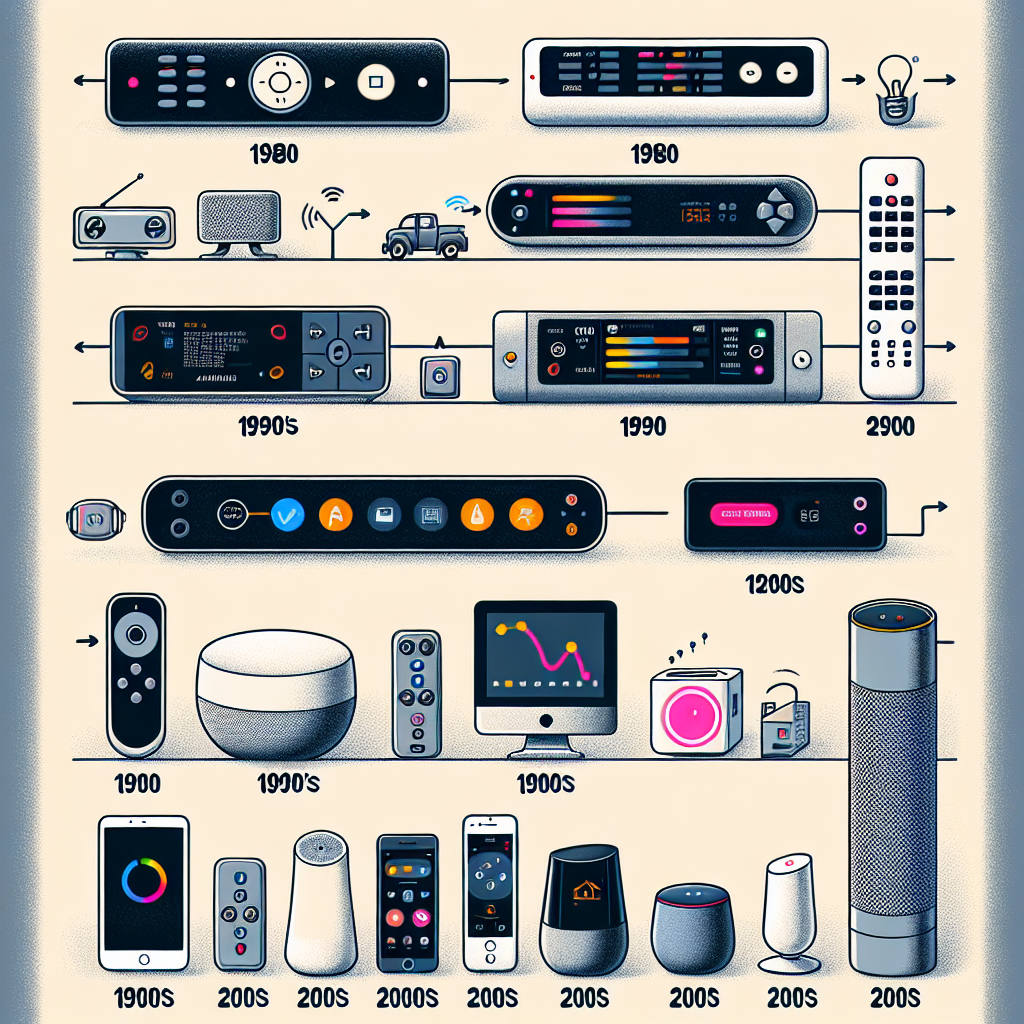-
Table of Contents
“Transforming Living Spaces: The Future of Smart Home Innovation”
Introduction

The Evolution of Smart Home Devices
The evolution of smart home devices has revolutionized the way we interact with our living spaces, transforming ordinary homes into interconnected hubs of convenience, efficiency, and security. From the early days of basic home automation systems to the sophisticated, AI-driven ecosystems of today, smart home technology has undergone significant advancements. Initially, smart home devices were limited to simple tasks such as controlling lighting and temperature. However, with the advent of the Internet of Things (IoT), these devices have become more integrated and intelligent, capable of learning user preferences and automating complex routines. Innovations in wireless communication, artificial intelligence, and sensor technology have further propelled the development of smart home solutions, making them more accessible and user-friendly. Today, smart home devices encompass a wide range of applications, including energy management, home security, entertainment, and health monitoring, offering unprecedented levels of comfort and control to homeowners. As technology continues to advance, the future of smart homes promises even greater integration, personalization, and sustainability, reshaping the way we live and interact with our environments.
The Rise Of Voice-Activated Assistants In Smart Homes
The evolution of smart home devices has been nothing short of revolutionary, transforming the way we interact with our living spaces. Among the myriad innovations, voice-activated assistants have emerged as a cornerstone of modern smart homes. These devices, which began as simple voice-activated speakers, have evolved into sophisticated hubs that control a wide array of home functions, making our lives more convenient and connected.
The rise of voice-activated assistants can be traced back to the introduction of Apple’s Siri in 2011, which was the first mainstream voice assistant integrated into a smartphone. However, it wasn’t until Amazon launched the Echo, featuring the Alexa voice assistant, in 2014 that the concept of a voice-activated smart home began to take shape. Alexa’s ability to perform tasks such as playing music, setting timers, and providing weather updates was a game-changer, and it wasn’t long before other tech giants followed suit. Google introduced Google Home with its Assistant in 2016, and Apple expanded Siri’s capabilities with the HomePod in 2018.
As these devices became more popular, their functionality expanded exponentially. Initially, voice-activated assistants were primarily used for simple tasks, but advancements in artificial intelligence and machine learning have significantly broadened their capabilities. Today, these assistants can control smart lights, thermostats, security systems, and even kitchen appliances. For instance, a user can now say, “Alexa, turn off the lights,” or “Hey Google, set the thermostat to 72 degrees,” and the assistant will execute the command seamlessly. This integration has made managing household tasks more efficient and has provided users with a greater sense of control over their environments.
Moreover, the integration of voice-activated assistants with other smart home devices has led to the creation of more cohesive and interconnected ecosystems. Companies like Amazon and Google have developed extensive partnerships with other smart device manufacturers, ensuring compatibility and ease of use. This has allowed users to create customized routines that can be activated with a single voice command. For example, saying “Good morning” might trigger a series of actions such as turning on the lights, starting the coffee maker, and providing a weather update. This level of automation has not only enhanced convenience but also contributed to energy savings and improved home security.
Despite these advancements, the rise of voice-activated assistants has not been without its challenges. Privacy concerns have been a significant issue, as these devices are always listening for their wake words, raising questions about data security and potential misuse. Companies have responded by implementing stricter privacy controls and providing users with more transparency regarding data collection and usage. Additionally, there have been efforts to improve the accuracy and reliability of voice recognition, particularly in noisy environments or for users with diverse accents.
Looking ahead, the future of voice-activated assistants in smart homes appears promising. As technology continues to advance, we can expect even greater integration and more intuitive interactions. Innovations such as natural language processing and contextual understanding will likely make these assistants even more responsive and capable of anticipating user needs. Furthermore, the expansion of 5G networks will enhance the speed and reliability of these devices, making real-time interactions smoother and more efficient.
In conclusion, the rise of voice-activated assistants has been a pivotal development in the evolution of smart home devices. From their humble beginnings as simple voice-activated speakers, they have grown into essential components of modern living, offering unparalleled convenience and connectivity. As technology continues to evolve, these assistants will undoubtedly play an even more significant role in shaping the future of smart homes, making our lives easier and more interconnected than ever before.
Integration Of AI And Machine Learning In Smart Home Devices
The integration of artificial intelligence (AI) and machine learning into smart home devices has revolutionized the way we interact with our living spaces. This technological evolution has not only enhanced convenience but also significantly improved the efficiency and functionality of our homes. As we delve into this fascinating development, it becomes evident that the seamless blending of AI and machine learning with smart home technology is transforming our daily lives in unprecedented ways.
Initially, smart home devices were relatively simple, offering basic automation features such as remote-controlled lighting and programmable thermostats. However, the advent of AI and machine learning has propelled these devices into a new era of sophistication. For instance, modern smart thermostats now learn from our behaviors and preferences, adjusting the temperature automatically to optimize comfort and energy savings. This level of personalization was unimaginable just a few years ago, highlighting the rapid pace of technological advancement.
Moreover, AI-powered voice assistants like Amazon’s Alexa, Google Assistant, and Apple’s Siri have become central to the smart home ecosystem. These intelligent assistants can control a myriad of devices, from lights and locks to entertainment systems, all through simple voice commands. The integration of natural language processing allows these assistants to understand and respond to complex queries, making interactions more intuitive and user-friendly. Consequently, the smart home experience has become more accessible to a broader audience, including those who may not be tech-savvy.
In addition to convenience, the integration of AI and machine learning in smart home devices has also enhanced security. Smart security cameras and doorbells, for example, now come equipped with advanced features such as facial recognition and anomaly detection. These capabilities enable the devices to distinguish between familiar faces and potential intruders, sending real-time alerts to homeowners. Furthermore, machine learning algorithms continuously improve the accuracy of these systems by learning from new data, ensuring that security measures remain robust and up-to-date.
Another significant benefit of AI and machine learning in smart home devices is energy efficiency. Smart lighting systems, for instance, can adjust brightness based on natural light levels and occupancy, reducing unnecessary energy consumption. Similarly, AI-driven energy management systems can analyze usage patterns and suggest ways to optimize energy use, leading to substantial cost savings and a reduced environmental footprint. This intersection of technology and sustainability is a testament to the positive impact that AI and machine learning can have on our lives.
As we look to the future, the potential for further integration of AI and machine learning in smart home devices seems boundless. Emerging technologies such as edge computing and 5G connectivity promise to enhance the capabilities of these devices even further. Edge computing allows for data processing closer to the source, reducing latency and improving real-time decision-making. Meanwhile, 5G connectivity will enable faster and more reliable communication between devices, paving the way for more complex and interconnected smart home systems.
In conclusion, the integration of AI and machine learning in smart home devices has ushered in a new era of innovation and convenience. From personalized climate control and intuitive voice assistants to enhanced security and energy efficiency, these advancements are reshaping our living environments. As technology continues to evolve, we can expect even more exciting developments that will further enrich our daily lives and redefine the concept of a smart home.
The Impact Of IoT On The Development Of Smart Home Technology
The Internet of Things (IoT) has revolutionized the way we interact with our living spaces, transforming ordinary homes into smart homes brimming with interconnected devices. This technological evolution has not only enhanced convenience but also redefined our daily routines. The impact of IoT on the development of smart home technology is profound, as it has enabled a seamless integration of various devices, creating a cohesive and intelligent ecosystem.
Initially, smart home technology was limited to basic automation, such as programmable thermostats and simple lighting controls. However, the advent of IoT has propelled this technology into a new era. Today, smart home devices are more sophisticated, capable of learning user preferences and adapting to individual needs. For instance, smart thermostats now use machine learning algorithms to optimize heating and cooling schedules based on the homeowner’s habits, resulting in significant energy savings.
Moreover, the integration of voice assistants like Amazon’s Alexa, Google Assistant, and Apple’s Siri has further amplified the capabilities of smart home devices. These voice-activated systems allow users to control various aspects of their home environment with simple voice commands, making the interaction more intuitive and user-friendly. Consequently, tasks such as adjusting the thermostat, dimming the lights, or even ordering groceries can be accomplished effortlessly, enhancing the overall user experience.
In addition to convenience, IoT has also bolstered the security of smart homes. Advanced security systems now include smart cameras, doorbells, and locks that can be monitored and controlled remotely via smartphones. These devices provide real-time alerts and video feeds, allowing homeowners to keep an eye on their property from anywhere in the world. Furthermore, the integration of artificial intelligence (AI) has enabled these systems to distinguish between regular activities and potential threats, thereby reducing false alarms and increasing reliability.
The proliferation of IoT has also paved the way for greater interoperability among smart home devices. Manufacturers are increasingly adopting open standards and protocols, ensuring that devices from different brands can communicate and work together seamlessly. This interoperability is crucial for creating a truly connected home, where various devices can collaborate to provide a unified and efficient experience. For example, a smart home system can synchronize the operation of lights, blinds, and thermostats to create an optimal environment based on the time of day and user preferences.
However, the rapid growth of IoT in smart home technology is not without its challenges. Privacy and security concerns are paramount, as the interconnected nature of these devices makes them susceptible to cyberattacks. Ensuring robust security measures and data encryption is essential to protect user information and maintain trust in smart home technology. Additionally, the complexity of setting up and managing multiple devices can be daunting for some users, highlighting the need for user-friendly interfaces and comprehensive support.
Despite these challenges, the future of smart home technology looks promising. The continuous advancements in IoT, AI, and machine learning are expected to drive further innovation, making smart homes even more intelligent and responsive. As these technologies evolve, we can anticipate a future where our homes not only cater to our needs but also anticipate them, creating a living environment that is both comfortable and efficient.
In conclusion, the impact of IoT on the development of smart home technology has been transformative, enhancing convenience, security, and interoperability. While challenges remain, the ongoing advancements in this field promise a future where smart homes become an integral part of our daily lives, offering unprecedented levels of comfort and efficiency.
Conclusion
The evolution of smart home devices has significantly transformed modern living by integrating advanced technology into everyday household functions. From basic automation systems to sophisticated, interconnected ecosystems, these devices have enhanced convenience, security, and energy efficiency. The continuous advancements in artificial intelligence, machine learning, and the Internet of Things (IoT) have driven this evolution, making smart homes more intuitive and responsive to user needs. As technology progresses, smart home devices are expected to become even more seamless, personalized, and integral to daily life, ultimately redefining the concept of home management and living standards.



